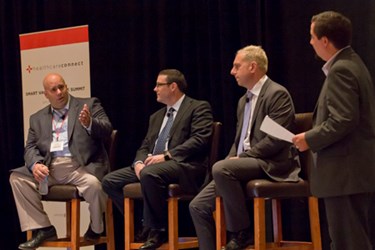Are You Targeting Healthcare IT's Biggest Pain Points?


At the Smart VAR Healthcare Summit, healthcare professionals aimed IT solutions providers at hospitals’ needs — and provided advice for how to contact and capture the attention of decision makers.
The summit, powered by ScanSource and Business Solutions on August 21 at the Westin Chicago Northwest, featured the healthcare end user panel:
- Dr. Seth Guterman, president of healthcare software company Empower Systems, president of a Chicago-based emergency care physician services company, and president of People’s Choice Hospital, an organization that buys and manages financially distressed acute care hospitals.
- Scott Farnsworth, corporate director of clinical systems development of Kindred Healthcare.
- John Daniels, VP of strategic relations for HIMSS (Health Information Management Systems Society). Before joining HIMSS, Daniels served as Senior VP and CIO at Evolvent Technologies, as CIO at the U.S. Air Force Academy Hospital, and VP of IT Operations for Harris County Hospital District. Daniels also delivered a keynote address during the morning general session.
What Are Healthcare’s Biggest IT Pain Points?
Panel moderator Mike Monocello, editor in chief of Business Solutions, first asked the panelists to share the biggest IT pain points they are facing.
Guterman comments, for hospitals that use electronic health records (EHR) systems, “There are a lot of peripheral computers out there that hospitals use to manage patients, to observe patients, and to keep track of how we’re doing. From our standpoint, that’s the issue we’re facing right now. We need cost effective, inexpensive products that can be easily integrated with our (EHR) systems.”
Farnsworth states there is a need for increased efficiency in healthcare: “I’ve had physicians come to me and say, I don’t need you to make me better, I need you to make me faster. And if you don’t make me faster, I won’t use your technology. The goal should be finding places — throughout the entire system, not just the EHR — where they can be more efficient.”
Daniels adds, “Looking to Meaningful Use Stage 3, we need to take all the disparate systems and get them to communicate with each other to get the full picture. We need to pull data into a single warehouse or repository where the organization can use the data and can do analysis.”
Who Are Healthcare IT’s Decision Makers?
Guterman points out selling IT solutions to a hospital can be complicated. “You have to get your message to the right person.” He says to consider the person’s title and what they’re most interested in — whether it’s IT, finances, compliance, or efficiency. “You have to craft your message to what that person cares about.”
“They get a million calls a day, but they’ll listen to you,” Guterman says. “Without you, they have no solution.”
Daniels advises, “Before you call, do your homework on that organization. Find out what they have, what they need, and what are the organization’s strategic objectives.” He says healthcare providers do their homework — they talk to vendors, look at what’s available on the market and analyze cost and ROI. “We do our homework. You do yours. “
Some suggestions for “homework” for IT solutions providers are attending meetings and presentations on healthcare IT, listen to the questions healthcare providers ask, and network. In addition, healthcare providers’ websites and investor information reveal projects and future plans.
Farnsworth adds, “Know something about the industry, and connect the dots …We don’t want to spoon feed anyone. We want someone to come to us that’s educated on the space.”
“If someone contacts us with something pertinent, we’re more than interested in what they have to say,” he says. “You have about 30 seconds to capture my attention. If you have that elevator pitch and I’m the right person, I’ll talk to you. If I’m not the right audience, I’ll tell you who is.”
Additional Advice From The Panel
- Future proofing is an important issue to hospitals, especially to large health systems with many facilities.
- The healthcare business has busy and slow seasons— knowing this can help you time your contact.
- Subscription-based cloud services will be handled as an operating expense, not a capital expenditure like other IT solutions, and the approval for those solutions could follow a different procedure.
- IT solutions providers can look beyond hospitals to other facilities — hospice, home health, nursing homes, telehealth — to provide solutions.
The Smart VAR Healthcare Summit features news on the latest trends in the healthcare vertical, secrets from successful healthcare VARs, and VAR opportunities in community and rural healthcare. The one-day event gives solutions providers the opportunity to meet colleagues and connect with healthcare channel leaders, to learn about new channel services, and to meet vendors. Technologies featured at the summit include mobile computing, bar coding, networking, asset tracking, wireless infrastructure, telehealth, and warehouse technologies.
Smart VAR Healthcare Summits, powered by ScanSource and Business Solutions, are sponsored by: Motorola, Honeywell, Datalogic, and Zebra.
